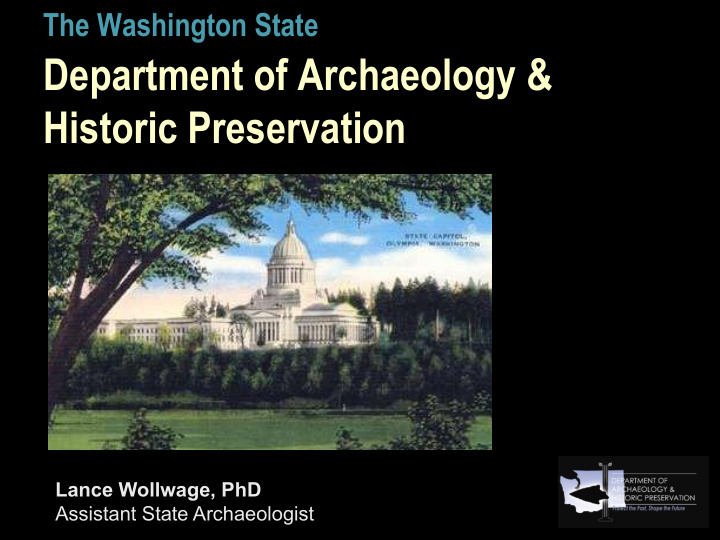



The Washington State Department of Archaeology & Historic Preservation Lance Wollwage, PhD Assistant State Archaeologist
State Historic Preservation Office(r) Established by the federal 1966 Historic Preservation Act Funded partly through the Historic Preservation Fund Also established by state legislatio n RCW 27.34
DAHP’s Mission To Preserve and Protect the Cultural Resources of Washington State For Future Generations RCW 27.34.200
DAHP regulates • Archaeological sites & excavations (RCW 27.53 & WAC 25-48) • Indian Graves & excavation (RCW 27.44) • Care and maintenance of abandoned Cemeteries (RCW 68.60) • Inadvertent discoveries of human remains that are not crime scenes (68.60 & 27.44)
RCWs 27.53 & 27.44 RCW 27.53: It is unlawful for any person or entity to knowingly and willfully alter or excavate any historic or prehistoric archaeological resource or site without a permit from DAHP RCW 27.44: INDIAN GRAVES AND RECORDS--burial sites, cairns, and glyptic markings located on public and private land are to be protected.
Common archaeological resources along shorelines Shell Midden
Glyptic Records Pictograph & Petroglyph Klickitat County, Columbia River Culturally Modified Tree Culturally Modified Tree (CMT)- historic period, (CMT), Gifford Pinchot Gifford Pinchot NF NF
Fish weirs Mud Bay, Thurston County
Other types of archaeological resources near shorelines Historic ferries and ferry landings Sites associated with timber extraction: docks, mills, storage facilities Fish processing sites (canneries) Military Installations Railroads, railroad camps Fur trade Exploration (i.e. Lewis and Clark) Irrigation features And much, much, more.
Submerged Resources • Shipwrecks – can be in shoreline zone but also much deeper waters • Other submerged archaeological resources: Galloping Gertie 1940
Galloping Gertie 2006
Good places for cultural resources Behind bulkheads, contemporary and old shorelines, buried shorelines (under fill), river deltas, confluences of creeks and rivers, confluences of creeks and Puget Sound, sandspits, wetland perimeters….
How does a property owner know they have a site or cemetery on their property? By Accident (not preferred)
Instead... Require surveys/archaeological work before the projects starts; SMA • and SEPA allow local governments (lead agencies) to prevent damage to sites during development by requiring surveys and data gathering in advance of the project Local governments have most authority in local permitting process or • administering the SEPA or SMP review • DAHP makes recommendations to local governments when they seek our opinion • State laws only provide for after-the-fact punishment, not pre- construction protocols
We recommend… Building archaeological consideration into normal permitting and • planning process, as with other environmental factors Include clear timelines so all parties know what is expected and how • long process will take Making the process as straightforward as possible, giving certainty to • the development community Ensuring the process conforms with RCW 27.53, 27.44 & cemetery • statutes
Planning Resources from DAHP • We keep the data: National Register Listed Properties • Archaeological sites and Cemeteries • Survey reports • • GIS based maps of known sites and historic properties • GIS based survey layers • WISAARD online www.dahp.wa.gov
Call DAHP anytime for questions, concerns, etc. Lance Wollwage, Assistant State Archaeologist, (360) 586-3536 www.dahp.wa.gov
Recommend
More recommend